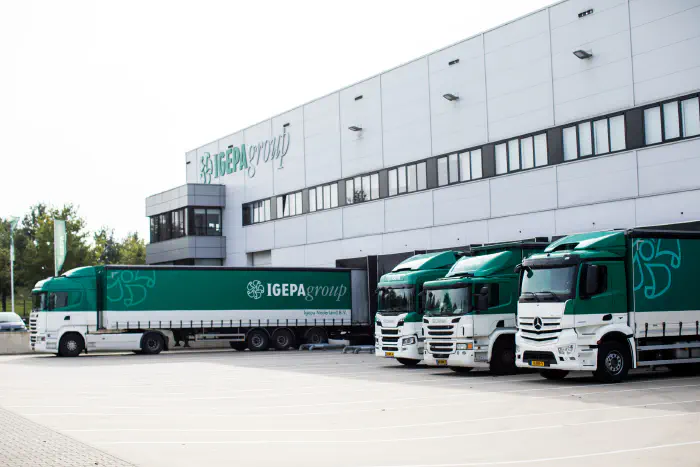

Digital transformation
Content
1. Digital transformation: going beyond the buzzword.
The concept of digital transformation has transcended its buzzword status over the past decade to become an important strategic initiative for companies.
It’s built out of a perspective that integrates technology into all areas of a business, changing how it operates and delivers value to customers. For most companies this shift is vital for staying competitive and adaptive in a rapidly evolving digital landscape.
In this article our approach to digital transformations is defined and explained.
1.1 Benefits of a digital transformation
Digital transformation refers to the use of new technology to create or modify existing business processes, culture, and customer experiences. Its purpose is to increase productivity and efficiency, generate more revenue, or mitigate risks.
Increased efficiency
Organizations can boost productivity by automating manual tasks. In addition, operations can be enhanced by leveraging data analytics. An approach that can lead to higher revenue because employees can dedicate time to other valuable activities.
Generating revenues
Creating an online presence helps organizations increase sales. They do this by offering customers targeted strategies, easy access, and quick responses. A superior customer experience can also boost loyalty and retention.
Mitigated risks
Organizations can improve risk decision quality by automating processes and decisions. They also benefit from digitized monitoring and early warnings. Our focus is on transparency, enhanced risk management, regulatory compliance, and precise model outputs.
2) Our vision
A digital transformation is not merely about adopting new technologies but involves a foundational change in how a business operates and delivers value to its customers.
At its core, a digital transformation aims to leverage the potential of new technologies to create or improve business processes, infrastructure, and customer experience. For founders, CEOs and C-level executives, understanding and implementing a digital transformation strategy is not just about technology; it’s about crafting a vision for the future of their organisation.
The necessity for digital transformation stems from a confluence of factors that are reshaping the landscape. Changing market dynamics, characterised by increased competition and shifting consumer preferences, demand a more agile and customer-focused approach to business. Combined with the rapid evolution of technology this creates opportunities for innovation, efficiency, and connectivity.
3) Our approach
Our approach to digital transformations is rooted in a structured, three-step methodology that guides organisations through the journey.
Each step is crafted to ensure a comprehensive understanding of the existing situation, a clear vision for the future, and a pragmatic action plan to bridge the gap between strategy and execution.
3.1 Assessment
We start with taking a step back to connect with your organisation and look at the bigger picture. A transformation should empower existing products and business models, enhance customer experiences, and optimise operations. That’s why our starting point is a comprehensive assessment. This makes it possible to align digital initiatives with your business objectives to build upon existing value and competitive advantages.
3.2 Future vision
In the second step we pivot towards the future. It involves establishing guiding principles based on the elements of People, Technology, and Process. A future vision, yet attainable digital perspective, is created that integrates with the organisation’s vision, mission and objectives. This future vision is presented comprehensively. Detailing the improvements across various business units of the organisation, including estimates of their financial impact.
3.3 Execution
The final step is about bridging the gap between strategy and execution. It encompasses developing an OKR roadmap, organisational charts, and budgeting, ensuring that the path from current to future state is pragmatically planned. Strategic intentions are translated into tangible actions, aligning budget, resources, and timelines to digital transformation objectives.
3.4 Digital transformation success stories
4) Digital transformation areas
The scope of digital transformation extends across all organisational areas, each playing a role in its overall success. Let’s take a look at examples for seven relevant areas.
Account Management
The right digital strategy enhances customer insights and service delivery in account management. Advanced CRM systems provide a detailed view of customer interactions, preferences, and feedback. This enables a customer-centric approach, and increases satisfaction and loyalty.
Dynamic pricing
Digital tools support dynamic pricing strategies. Businesses can adjust prices based on market demand, competitor pricing, and customer behaviour. Advanced analytics help identify optimal pricing models. This maximises profitability while ensuring competitiveness.
E-Commerce
A solid digital strategy improves the user experience on websites and manages inventory effectively. AI integration offers personalised recommendations. Analytics help understand consumer behaviour, boosting online sales.
Purchasing and Logistics
A digital strategy streamlines purchasing and logistics. The right ERP and SCM software improve efficiency. Automation can reduce lead times and operational costs, tailoring these aspects to your organisation.
Finance
Digital transformation automates and optimises financial operations and reporting. Tools for digital budgeting, forecasting, and secure transactions with blockchain increase accuracy and efficiency. Digital strategies assist in compliance management and risk assessment, improving financial health.
Marketing and Sales
Digital strategies use AI, data analytics, and modern tooling in marketing and sales. These technologies automate tasks and enable effective tactics, increasing sales and customer retention.
People and culture
The right technology can significantly impact the people aspect of an organisation. Digital HR solutions improve the employee experience and productivity. While the right organisational and cultural approach elevates operating standards.
Incorporating the right technologies into these areas can not only enhance their performance but also create synergies that propel the entire business forward. Focusing on the relevant digital transformation areas is crucial for driving strategic growth and ensuring long-term success.
5) A strategic partnership along the journey
For a digital transformation to be successful, it cannot operate in silos nor can it be solely the purview of the IT department. The board and C-level executives play a pivotal role in leading and championing these initiatives. Their involvement signifies an organisation-wide commitment to change, setting the tone for transformation efforts and ensuring alignment across all levels of the company.
The board’s role extends beyond mere approval of digital initiatives; it involves active participation in defining the digital vision, ensuring that it aligns with the company’s overall strategic goals. Leaders are tasked with fostering a culture that embraces change, innovation, and digital thinking at its core. This includes allocating the necessary input to drive these initiatives forward.
This is the reason why Momentum actively supports before, during and after advisory projects. In essence, we act as a strategic partner to the board and C-level executives, offering expertise and support at every stage of the digital transformation journey. This partnership ensures that leadership is not only prepared to guide their organisation through the complexities of digital change but also equipped to drive a culture of innovation and digital excellence.
FAQ
What is digital transformation?
Digital transformation refers to the use of new technology to create or modify existing business processes, culture, and customer experiences. Its purpose is to increase productivity and efficiency, generate more revenue, or mitigate risks.
Why are digital transformations relevant?
It’s essential for keeping up with evolving customer expectations and staying competitive in a fast-paced digital world. Companies that embrace digital transformation can improve efficiency, enhance customer experience, and unlock new opportunities for innovation and growth.
What are the key components of a successful digital transformation strategy?
A successful digital transformation strategy should include a clear vision, commitment from top management, a customer-centric approach, investment in the right technology, and fostering a culture of innovation and agility.
What are the common challenges in digital transformation?
Common challenges include lack of a clear strategy, technology integration issues, resistance to change due to lack of incentives and motivation, and ensuring cybersecurity and data compliance.
How does digital transformation impact customer experience?
Digital transformation enables businesses to offer personalised and seamless customer experiences across various digital channels. By leveraging data analytics and AI, companies can better understand customer needs and preferences, leading to increased customer satisfaction and loyalty.





